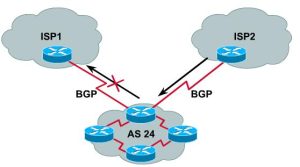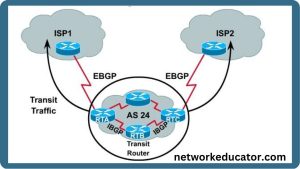An Autonomous System (AS) is any large network that shares similar routing policies and operates within a single administrative domain. Each AS is assigned a unique ASN, which is a number that identifies the AS.
An AS can be a collection of routers running a single IGP, or it can be a collection of routers running different protocols all belonging to one organization. In either case, the outside world or the Internet views the entire AS as a single entity.
AS value lies between 1 and 65,535.
AS numbers within the range, 64,512 through 65,535 are reserved for private use (similar to RFC 1918 IP addresses). These private AS numbers appear only within the provider’s network and are replaced by the provider’s registered number upon exiting the network. Thus, to the outside world, several individual networks are advertised AS part of one service provider’s network. In principle this is similar to NAT.
Autonomous System have types
- Single homed AS
- Multi homed non-transit AS.
- Multi-homed transit AS.
Single Homed Autonomous System
Table of Contents
- If in an AS only one exit point to outside networks, called single-homed system.
- Single-homed AS are often referred to AS stub networks or stubs.
- Stubs can rely on a default route to handle all traffic destined for non-local networks
 Example – Single Homed Autonomous System
Example – Single Homed Autonomous System
Multihomed Non-transit Autonomous System
- An AS is a multi-homed system if it has more than one exit point to outside networks.
- An AS connected to the Internet can be multi-homed to a single provider or multiple providers.
- A non-transit AS does not allow transit traffic to pass through it.
- Transit traffic is any traffic that has a source and destination outside the AS.

Example – Multi Homed Non-Transit Autonomous System
The figure illustrates a multi-homed and non-transit AS (AS 24), which is connected to two providers, ISP1 and ISP2.
- Â A non-transit AS would advertise only its own routes to both providers to which it connects.
- It would not advertise routes that it learned from one provider to another.
- This ensures that ISP1 will not use AS 24 to reach destinations that belong to ISP2, and vice versa. Of course, ISP1 or ISP2 can force traffic to be directed to AS 24 via default or static routing. As a precaution against this, the router at the border of AS 24 could filter incoming traffic to prevent transit traffic from passing through.
Multihomed Transit Autonomous System
- A multi-homed transit system has more than one connection to the outside world and can be used for transit traffic by other autonomous system.
- A transit AS can route transit traffic by running BGP internally so that multiple border routers in the same AS can share BGP information. Additional routers may be used to forward BGP information from one border router to another. You may choose to run BGP inside an AS to facilitate this exchange

Example – Multi Homed Transit Autonomous System
Frequently Asked Questions:
Q. What is an AS ?
A: An AS is a group or collection of a network associated with Internet Protocol (IP) that share similar routing policies and operate within a single administrative domain.
Q. Name different types of AS ?
A: There are three types of AS which are as below.
- Single homed AS
- Multi homed non-transit AS.
- Multi-homed transit AS.
Very nicely explained
Thanks Bro.